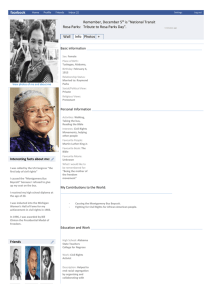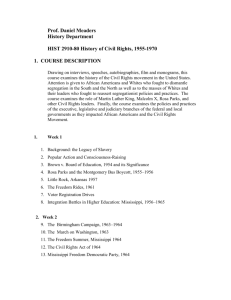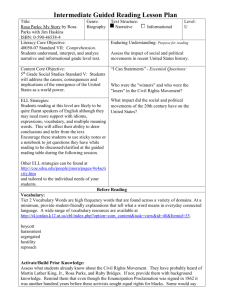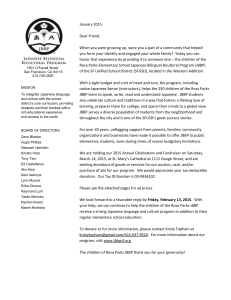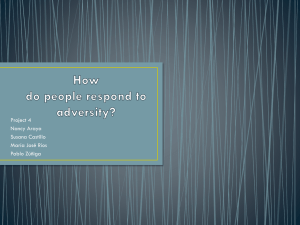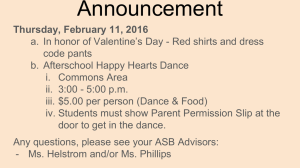LIBRARY OF CONGRESS – PATHWAYS CIVIL RIGHTS
advertisement
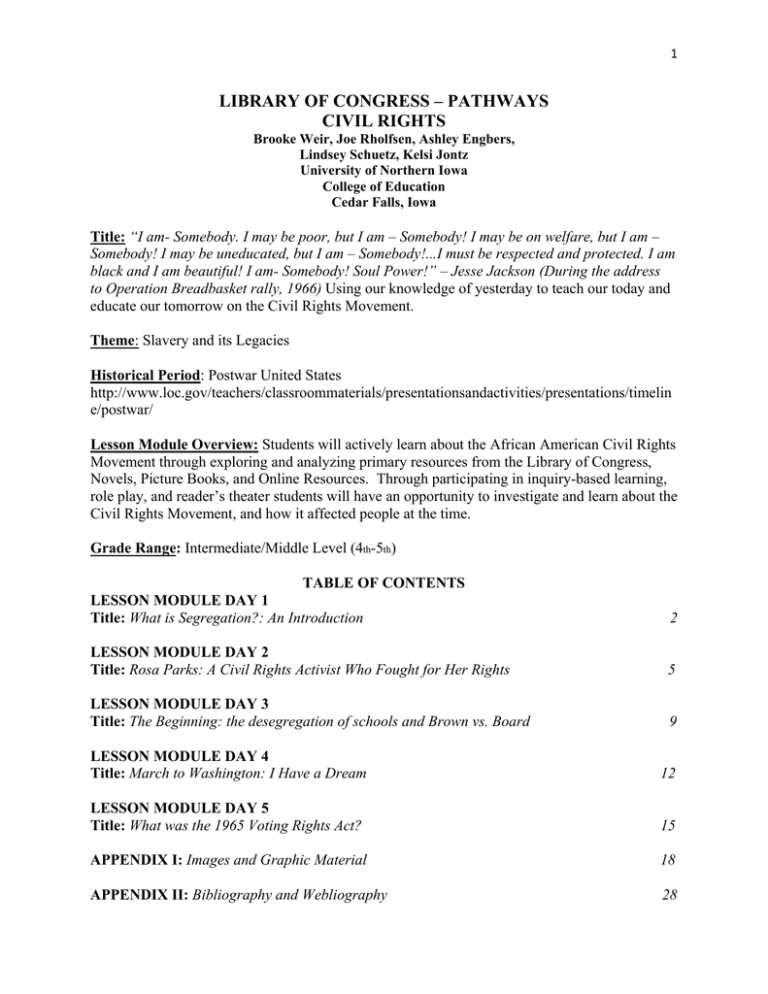
1 LIBRARY OF CONGRESS – PATHWAYS CIVIL RIGHTS Brooke Weir, Joe Rholfsen, Ashley Engbers, Lindsey Schuetz, Kelsi Jontz University of Northern Iowa College of Education Cedar Falls, Iowa Title: “I am- Somebody. I may be poor, but I am – Somebody! I may be on welfare, but I am – Somebody! I may be uneducated, but I am – Somebody!...I must be respected and protected. I am black and I am beautiful! I am- Somebody! Soul Power!” – Jesse Jackson (During the address to Operation Breadbasket rally, 1966) Using our knowledge of yesterday to teach our today and educate our tomorrow on the Civil Rights Movement. Theme: Slavery and its Legacies Historical Period: Postwar United States http://www.loc.gov/teachers/classroommaterials/presentationsandactivities/presentations/timelin e/postwar/ Lesson Module Overview: Students will actively learn about the African American Civil Rights Movement through exploring and analyzing primary resources from the Library of Congress, Novels, Picture Books, and Online Resources. Through participating in inquiry-based learning, role play, and reader’s theater students will have an opportunity to investigate and learn about the Civil Rights Movement, and how it affected people at the time. Grade Range: Intermediate/Middle Level (4th-5th) TABLE OF CONTENTS LESSON MODULE DAY 1 Title: What is Segregation?: An Introduction 2 LESSON MODULE DAY 2 Title: Rosa Parks: A Civil Rights Activist Who Fought for Her Rights 5 LESSON MODULE DAY 3 Title: The Beginning: the desegregation of schools and Brown vs. Board 9 LESSON MODULE DAY 4 Title: March to Washington: I Have a Dream 12 LESSON MODULE DAY 5 Title: What was the 1965 Voting Rights Act? 15 APPENDIX I: Images and Graphic Material 18 APPENDIX II: Bibliography and Webliography 28 2 LESSON MODULE DAY 1 Title: What is Segregation?: An Introduction Learning Goals: Knowledge -Students will understand the term “segregation” and begin exploring resources about segregation during the Civil Rights movement. -Students will develop an understanding of what it is like for some individuals to be treated equally through literary connections. -Students will begin to understand how segregation played a huge role during the Civil Rights movement. Skills -Students will participate in a role-play activity centered on the segregation during the Civil Rights movement. -Students will begin exploring various types of primary sources such as images, novels, and poems. Dispositions -Students will begin to develop an ability to evaluate multiple perspectives on equality and segregation. -Students will be able to think critically about how equality and segregation impacted the past and begin to understand the complexity of equality and segregation as a historical issue. National Council for the Social Studies Themes: http://www.socialstudies.org/standards/strands Culture: Social studies programs should include experiences that provide for the study of culture and cultural diversity. Time, Continuity, & Change: Social studies programs should include experiences that provide for the study of the past and its legacy. Power, Authority, & Governance: Social studies programs should include experiences that provide for the study of how people create, interact with, and change structures of power, authority, and governance. Materials Needed: 3 Copy of Sources of Light by Margaret McMullan Copy of The Story of Ruby Bridges by Robert Coles Computer Access for Each Group Dictionary/Thesaurus,Online Dictionary/Thesaurus Primary Resources for “Picture This” enactments (see Appendix I (Images 1-6)) Lesson Procedures: Introduction 1. Grab the students’ attention by leading into our subject matter with a short unknown to the student demonstration. This demonstration needs to be one that shows inequality between the students. 2. One such example could be to have all of the girls come to the front of the class to select a piece of paper. The girls will have their choices between glitter, bright, and bold colors of paper; afterward, the boys will come up and be handed a plain white piece of paper. The students will then be asked to draw something on the paper. 3. Once the students are done drawing their pictures tell them they can bring their pictures to you. At this time you will post all of the girls’ pictures around the class and lay the boys’ pictures on your desk. 4. After the students seem very confused and/or frustrated with the chain of events, ask them to explain how they feel right now. Right the words on the board/ELMO. 5. Ask the students why they think you did this? Fill the room with the discussion. 6. After the students have had time to ponder why you would possibly do this explain to them that you were trying to show them how African Americans felt during the Civil Rights movement. 7. Ask the students if this changes how they feel about what happened? Why or Why not? 8. Ask the girls what if felt like to have their priorities be placed higher than the boys? Ask the boys what it felt like to not be a priority? 9. Lead to a discussion on what things students already know about the Civil Rights movement and what they know about the difference between the whites and African Americans at that time. Also discuss why the students think the African Americans were treated that way. Why wasn’t it fair? Development 1. Write the following historical inquiry questions on the board: “What is segregation? How did segregation play a part in the Civil Rights movement?” 2. Go over the vocabulary “Civil Rights” first. Ask students, “What are Civil Rights?” 3. Support students understanding of the phrase by allowing them to use a dictionary or online dictionary on the ELMO. Afterward, put the definition on the board. (“Civil Rights”-the nonpolitical rights of a citizen; especially; the rights of personal liberty guaranteed to United States citizens by the 13th and 14th amendments to the Constitution and by acts of Congress. Merriam Webster online dictionary - http://www.merriamwebster.com/dictionary/civil%20rights) 4 4. Ask students what questions they have about the topic and write them down to look back at later. 5. Let the students know that they will be getting a closer look at segregation and the Civil Rights movement. Inform them that you will start doing this by reading Sources of Light by Margaret McMullan or The story of Ruby Bridges by Robert Coles. 6. Stop frequently throughout reading the novel to check comprehension. Once finished, ask the students to help make a list now of what they have learned about segregation and the Civil Rights movement on the ELMO Culmination 1. Split the student up into five groups and hand each group a primary source. 2. Ask the students to use the primary source and what they know about segregation and the Civil Rights movement to create a production of their choice. 3. The production could be a rap, short narrative, song, poem, or something else of their choice. Make sure they present their idea to you before they start working. Ask that the only restriction is that they show what they have learned about segregation and the Civil Rights movement. 4. Show an example using the first image (Found in Appendix I- A picture of a boy drinking from a “colored” drinking fountain. For this example you could use the following rap: Segregation, Segregation Together Blacks and Whites can’t drink Segregation, Segregation We need to find the missing link Segregation, Segregation I will fight for Civil Rights Segregation, Segregation I will fight with all my might Assessment 1. Student will show their productions to the class and show what they have learned about segregation and the Civil Rights movement. 5 LESSON MODULE DAY 2 Title: Rosa Parks: A Civil Rights Activist Who Fought for Her Rights Learning Goals: Knowledge -Students will understand Rosa Parks’ impact on the Civil Rights Movement and her impact on American history. -Students will understand the life of Rosa Parks including a biography of where she was born, where she grew up, what she did for a living, and what she did for the Civil Rights Movement. -Students will develop an understanding of how African Americans felt being separated from the whites and what Rosa Parks experienced and how she felt prior to, during, and after the Montgomery bus incident. -Students will begin to understand the history of the Civil Rights Movement involving Rosa Parks and the Montgomery bus incident. Skills -Students will participate in a Reader’s Theater activity centered on Rosa Parks’ life and the impact she had on the Civil Rights Movement. -Students will explore and use various Primary Resources, including images, from the Library of Congress to develop a Reader’s Theater describing the life and impact of Rosa Parks including her biography and emotions regarding segregation and her moment on the bus that started a change for the African American population. Dispositions -Students will begin to develop an ability to evaluate various Primary Resources, including images, from the Library of Congress to think critically about and develop an understanding of past people (Rosa Parks) and events (the Montgomery bus incident and Civil Rights Movement) that have shaped American history. National Council for the Social Studies Themes: http://www.socialstudies.org/standards/strands Time, Continuity, and Change: Social studies programs should include experiences that provide for the study of the past and its legacy. 6 People, Places, and Environments: Social studies programs should include experiences that provide for the study of people, places, and environments. Power, Authority, and Governance: Social studies programs should include experiences that provide for the study of how people create, interact with, and change structures of power, authority, and governance. Civic Ideals and Practices: Social studies programs should include experiences that provide for the study of the ideals, principles, and practices of citizenship in a democratic republic. Materials Needed: -Rosa Parks KWL Chart (Poster board divided into three sections: a K for what students know, W for what students want to learn, and L for what students learned after the lesson) -Markers/Writing utensil for KWL Chart -A Picture Book of Rosa Parks (Children’s Book written by David Adler) -Primary Resources from the Library of Congress for “Rosa Parks: Her Life History and Story”Reader’s Theater developed by students -Computer to create Reader’s Theater scripts (Paper and Pencils if computer is not available) -Props (optional) Lesson Procedures: Introduction 1. Begin the lesson by filling out the KWL Chart with the students. First, fill out the K by asking students to describe what they have heard or what they already know about Rosa Parks. (Be sure to document the responses on the KWL Chart.) 2. Also, inform students you would like to fill out the W part of the KWL Chart. The W stands for what students would like to learn. Allow the students some time to share ideas and information they would like to learn regarding Rosa Parks. (Be sure to document the responses on the KWL Chart.) 3. Tell students the objective of this lesson is for students to develop a thorough understanding of who Rosa Parks was and what she did as a civil rights activist. Also, inform students Rosa Parks had a major impact on the lives of African Americans when she refused to give up her seat at the front of the bus, where only whites were allowed to sit. 4. Next, inform students a story will be read aloud to them about Rosa Parks. The story is called A Picture Book of Rosa Parks written by David Adler. a. The book describes the civil rights activist, Rosa Parks, who initiated the Montgomery bus boycott. The book also describes the history that had led to the boycott including school desegregation and the Ku Klux Klan. The book provides additional information regarding the Tuskegee Institute, Thurgood Marshall, and Brown versus Board of Education case. 7 b. While reading the story, provide students with opportunities to make predictions, comments, concerns, and questions. 5. Tell students after the lesson, students will be expected to fill out the L on the KWL Chart which identifies what students learned from the lesson. Development 6. Break students into 4 equal groups. Provide each group with a Primary Resource (see Appendix I). 7. Inform students the Primary Resources were made available from the Library of Congress. The Primary Resources, or pictures, display various moments in Rosa Parks’ life as a civil rights activist and bus boycott leader. 8. Tell the students each group has a different picture. With the picture, each group will develop a Reader’s Theater, or skit, describing the scene they believe is taking place. It is also important for you to include how Rosa Parks feels or what she is thinking during the different situations. Inform students they are able to be creative with the Reader’s Theater in order to accurately describe the scene, emotions, and reactions taking place in the pictures. a. It will be beneficial to review main points of a Reader’s Theater. If the teacher would like, props may be used. 9. Allow students time to brainstorm, research (see beneficial Children’s Literature and Webliography), and develop a Reader’s Theater script for their assigned picture (depending on the students and how specific/accurate the teacher would like the information and act to be, this activity may take several days). a. If students are stuck, provide them with helpful resources and ideas: Picture 1 of Rosa Parks could be used to provide a biography or background of Rosa Parks including when and where she was born, where she grew up, what she did for a living, and why she wanted to bring about change. Picture 2 of Rosa Parks on the bus may describe what happened on the day she refused to give up her seat. Students may describe how Rosa and the people on the bus felt. It may also describe how the bus situation led to the bus boycott. Picture 3 of Rosa Parks getting her finger print may describe what happened to Rosa Parks as a result of the bus situation. Picture 4 of Rosa Parks walking with the others may describe how the bus situation or civil rights issues were settled. The picture may also describe how Rosa Parks felt after the issues were settled. Culmination 10. To conclude the activity, students will present their Reader’s Theater using the assigned Primary Resource of Rosa Parks in front of the class. 8 a. It would be beneficial to have students present in this order: Picture 1 with Rosa Parks only, Picture 2 with Rosa Parks on the bus, Picture 3 with Rosa Parks getting her finger print, and Picture 4 with Rosa Parks walking with the others. b. The Reader’s Theater presentation may be recorded so students are able to watch the final video of their presentations. 11. After the presentations, allow students time to reflect upon what they have learned from the story read aloud, research, pictures, and Reader’s Theater. Have students write down thoughts, feelings, comments, questions, or concerns. (The teacher should review these after the lesson has been completed and address any comments or questions as needed.) 12. Inform students you would like to fill out the L of the KWL Chart in order for students to share what they had learned from the lesson. Assessment Students will be assessed based upon their accuracy of information regarding the event, thoughts, and emotions regarding the event taking place in their assigned picture through a Reader’s Theater presentation. Students will also be assessed based upon their comments, thoughts, and information provided to complete the L on the KWL Chart. 9 LESSON MODULE DAY 3 Title: The Beginning: the desegregation of schools and Brown vs. Board Learning Goals: Knowledge: -Students will understand the term desegregation and begin exploring resources about the desegregation of schools. -Students will develop an understanding of what it is like for some individuals to be denied the same education through a class simulation. -Students will begin to understand the key events related to the desegregation of schools. -Students will begin to understand how much things have changed from where they were before the desegregation of schools. -Students will discuss the differences between schools know and how schools were before desegregation. Skills: -Students will participate in a role-play activity where they learn that things were different in school if you were a student who had a different color skin other than white. -Students will participate in a discussion about the differences that they see from how school was when they desegregated the schools and how the schools are today. Dispositions: -Students will appreciate the schooling that they have today instead of what school used to be like before desegregation. -Students will relate their feelings of their own experience with segregation with what they saw in the pictures and what they saw in the movie Remember the Titans. National Council for the Social Studies Themes: http://www.socialstudies.org/standards/strands Time, Continuity, & Change: Social studies programs should include experiences that provide for the study of the past and its legacy. Power, Authority, & Governance: Social studies programs should include experiences that provide for the study of how people create, interact with, and change structures of power, authority, and governance. Civic Ideals & Practices: Social studies programs should include experiences that provide for the study of the ideals, principles, and practices of citizenship in a democratic republic. 10 Materials: -Textbooks-some new and some old used textbooks -Remember the Titans Movie -Paper -Markers -Pictures of Brown vs. Board of Education and the desegregation of schools -Notebooks -Pencils -History channel clip called “Separate but not Equal”- http://www.history.com/videos/brown-vsboard-of-education-separate-is-not-equal#brown-vs-board-of-education-separate-is-not-equal Lesson Procedure: Introduction: 1. Start the lesson by splitting up the room and have all the students with blonde/light hair on one side of the room and all the students with brown/dark hair on the other side of the room. 2. Once the students have moved tell the students that this is how we are going to be sitting for this lesson today. 3. Then begin to pass out the text books. Give the students with brown/dark hair the nice new textbooks and give the students with blonde/light hair the old used textbooks. Then start pretending to teach a lesson out of the book. 4. Speak directly to the students with brown/dark hair and try not to call on the students with blonde/light hair. After a few minutes tell the students to pass up their textbooks and have them go back to their original seats. 5. Then ask the students about what just happened. Ask questions like: 1. How did you feel when you were given the new textbooks and you saw some of your friends were given used old textbooks? 2. How were you feeling when I wasn’t speaking to you and I was ignoring you? 3. How would you feel if that is how every class was like that? 4. Did you know that schools use to be like that? 6. Start the discussion about how schools used to be like this back before they desegregated the schools because of one decision. Development: 1. Start by writing the term Brown vs. Board of Education and desegregation of schools on the board. Ask the students if they know anything about these terms and what they mean to them. 2. After the students have told you what those words mean to them show them pictures of what those terms are and then give the students the terms to write in their notebooks. 3. Then tell them that the schools use to be like our little skit that we did at the beginning of the lesson. Tell them that the only difference between the two is that in students of color were not allowed to be in the same school. The people didn’t think that they needed to be in the same school and that they didn’t need the same materials. 4. Show students the video from the History Channel called “Separate but not equal” . 11 5. Ask students what questions they have about the video clip. Write them down so that you can remember what the questions were and have them for students if they want to look them up if you can’t answer them. 6. Then inform the students that that this decision was a great one but many people were not excited about this decision. They didn’t think it was fair. Some people wanted to go out of their way to hurt the people and the police had to do something about that. 7. Show the students the picture of the police holding off the crowds. Then show the students a clip from the movie Remember the Titans. The clip is from the start of chapter 14 of the dvd which is the 47:55 minute to the 49:30 minute of the movie. 8. Once the clip is over have the students sit in a circle around the room for a discussion on what they just saw. Culmination: 1. Have a big piece of paper write down what the students see as similarities between the picture and the clip from the movie. Also write down what the students are feeling and what they thought about the clip and what life was like back then. 2. Once you have finished the discussion have the students go back to their seats and have them get out their journals to write down what they learned from the lesson and how they think that the schools would be different if the decision for Brown vs. Board of Education was different. Assessment: 1. Have the students write in their journals what they learned from the lesson. Have them write down how they think schools would have been different had they not had the Brown vs. Board of Education decision. This will show you what the students learned from the lesson and if the lesson was effective in teaching the students about how much the schools have changed since the Brown vs. Board of Education. 12 LESSON MODULE DAY 4 Title: March to Washington: I Have a Dream Learning Goals: Knowledge: -Students will analyze the “I have a dream” speech made by Martin Luther King Jr. in the March to Washington and recognize what it was he was fighting for. -Students will develop and understanding of the importance of this speech for our country. Students will recall facts about Martin Luther King Jr. learned from earlier units and recall the importance of what he did for this country. -Students will identify the feelings that African Americans may have been dealing with at this time. -Students will relate to the speech by writing their own speech about something that they believe in. Skills: -Students will learn and apply research skills through resources given to them over the lesson topic. Dispositions: -Students will appreciate their right to freedom of expression through the writing of a speech about a topic in which they feel strongly about. -Students will relate the feelings on the day of the Washington March to feelings in their own lives. National Council for the Social Studies Themes: http://www.socialstudies.org/standards/strands Time, Continuity, and Change: Social studies programs should include experiences that provide for the study of the past and its legacy. People, Places, and Environments: Social studies programs should include experiences that provide for the study of people, places, and environments. Individual Development and Identity: Social studies programs should include experiences that provide for the study of individual development and identity. Power, Authority, and Governance: Social studies programs should include experiences that provide for the study of how people create, interact with, and change structures of power, authority, and governance. 13 Materials: Video of the “I Have a Dream” speech - http://www.youtube.com/watch?v=wQQyIj-wDyg Books about Martin Luther King Jr. Journals Pens Pictures of the March Lesson Procedure: Introduction: 1. Show students pictures of exerts from the March to Washington. Explain to them briefly what the march was about and ask them to identify anyone in the crowd that they recognize. This picture will have Martin Luther King Jr. in it so that the students can pick him out of the crowd. 2. Ask the class what they remember about Martin Luther King Jr. Day. We will have learned about him prior to this event. What do they remember about what he did. Have one child from each group come up to the board and write one thing that they recall about him. 3. Have a small discussion as a class about MLK so that everyone is caught up Development: 1. 2. 3. 4. 5. 6. 7. Play a small clip from the “I have a dream” so that students can see the abundance of people that were at this March. Do not show a portion of the speech, but the crowd in the speech to get a feel for the energy of the group. Next, play a clip of the “I had a dream” speech made by Martin Luther King Jr. on that day. After the clip is played, have a discussion in small groups about what Martin Luther King Jr. was trying to say through his speech. What was he trying to do? What did he believe in? Why was it important? Students can take time to journal about this speech in their class journals. Show the students the pictures of the people at the march again. Have them look closely at their faces and think of their stories. What are these people thinking? Can they put themselves in their places? Ask each of the students if they have done anything that they are proud of? Have they ever stood up for anything before? Do they have anything that they would stand up for right now? Give each of the students copies of a portion out of the “I have a Dream” Speech. They can use this to guide them in how they want to write their speech. It is obvious through this speech that MLK was passionate about what he believed in and it will be a good example. Each student is going to write their own speech about something they believe in. It is important for them to choose a topic that they are passionate about. The speech can be as long as they think it needs to be, but it needs to start with “I have a dream”. 14 Culmination: 1. Conclude the lesson by having the students volunteer to give their speeches to the class while the rest of the class does a “mach march”. Students can have made signs representing something that they are standing for so that they can hold them up during the march. - This portion can be video recorded if anyone wants to watch their speech. This would also allow parents the opportunity to see it. Assessment: 1. Evaluate the effectiveness of the lesson by examining the speeches and seeing how much thought is carefully put into them. Also, students can hand in journals where you can assess comprehension of the meaning of MLK’s speech. Have the students understood the meaning of the assignment? 15 Lesson Module DAY 5 Title: What was the 1965 Voting Rights Act? Learning Goals: Knowledge: -Students will learn about the 1965 Voting Rights Act and how it affected African American lives. -Students will understand what it was like to be an African American before the 1965 Voting Rights Act was developed. -Student’s will discover and learn about the key people that were involved in creating the 1965 Voting Rights Act. Skills: -Students will begin exploring various types of sources to gather important information about the 1965 Voting Rights Act. -Students will begin to organize their information and choose between important information and information that can be left out of their findings. Dispositions: -Students will begin to develop an understanding of the historical importance of the 1965 Voting Rights Act and the role it plays in today’s society. National Council for the Social Studies Themes: http://www.socialstudies.org/standards/strands Time, Continuity, and Change: Social studies programs should include experiences that provide for the study of the past and its legacy. People, Places, and Environments: Social studies programs should include experiences that provide for the study of people, places, and environments. Individual Development and Identity: Social studies programs should include experiences that provide for the study of individual development and identity. Power, Authority, and Governance: Social studies programs should include experiences that provide for the study of how people create, interact with, and change structures of power, authority, and governance. Materials: -Book: Mississippi Challenge by Mildred Pitts Walter -Writing utensil -Lined paper 16 Lesson Procedure: Introduction: 1. Grab the student’s attention by explaining to them that today we’re going to take a vote to see what game is going to be played at PE. 2. Tell the students that their two choices are freeze tag or regular tag. Ask the students to raise their hand for what game they want to play and place tally’s on the board to see what game has the most votes. 3. Abruptly stop counting and divide the class into half. Tell them, “I forgot to tell you, this half of the classes votes aren’t going to count. We are going to pretend it is 1964 and not everyone had the right to vote at that time.” 4. Ask the half of the class with voting rights to raise their hands again and tally their votes on the board. 5. After all the votes have been tallied tell the class that you will let the PE teacher know what game you want to play in class today. 6. After all the voting has been done, lead a class discussion on the following questions: 1. How did the half of the class that didn’t get to vote feel? Why? 2. How did the half of the class that did get to vote feel? Why? 3. Ask certain students that didn’t get to vote if their game got chosen. If not, ask them how that makes them feel. 7. Aim to lead the discussion in a positive manner about how this was not fair and how African Americans felt about not being able to vote. Also be sure to inform the class that this was just an example and that they won’t actually be playing the game that got the most votes. Development: 1. Write on the overhead or board the following question: What was the 1965 Voting Rights Act? Have students talk to a classmate for a few minutes then ask for volunteers to give an answer. 2. Write student’s answers on the board and have the students write them down in their notebooks so they can refer back to them later. 3. Read pages 176-183 from Mississippi Challenge and tell students to add any new information to their notes. Check periodically throughout the reading for students understanding and once the reading is over, ask the students what new information we can add to our list about the 1965 Voting Rights Act 4. Tell students that throughout the week they will be spending time researching about the 1965 Voting Rights Act and adding any new information to their notes they may not have. 5. Encourage students to talk to parents and guardians to further develop their notes about the 1965 Voting Rights Act. Culmination: 1. Create a place in the classroom where students can go to continue learning about the 1965 Voting Rights Act. 17 2. Have books, posters, and pictures that students can look at during appropriate times throughout the day and encourage them to continually add any new information to their notes. 3. Have a list of websites students can visit on the computer to find information. If the classroom doesn’t have a computer schedule a day where the entire class can go to the computer lab to research the 1965 Voting Rights Act. Assessment: 1. Have the student’s hand in an “Exit Slip” that includes two things they learned about the 1965 Voting Rights Act and one question that they have about the Act. This can be used by the teacher for future lessons. 18 APPENDIX I: IMAGES AND GRAPHIC MATERIALS FROM THE LIBRARY OF CONGRESS 1. Image Man drinking from a segregated water cooler in an Oklahoma City street car terminal. Oklahoma City, Oklahoma, July 1939. 19 2. Image One of the actual uniforms of the Ku Klux Klan. In Birmingham, Alabama, 1946. 20 3. Image Drinking fountain on the county courthouse lawn, Halifax, North Carolina, April 1938. 21 4. Image People waiting in line outside the Supreme Court for hearings on the constitutionality of segregation in public schools. 22 5. Image A long line of African Americans picket outside Rich's Department Store, Atlanta, Georgia, in protest against segregated eating facilities at one of its lunch counters, 1960. 23 6. Image Willie Brown and Doug Stewart walking with signs in civil rights protest march. 24 7. Image Rosa Parks had a major impact on the Civil Rights Movement and the lives of African Americans to this day. Rosa Parks was born on February 4, 1913 in Tuskegee, Alabama, but grew up in Montgomery, Alabama. 25 8. Image Rosa Parks seated towards the front of the bus where African Americans were not allowed to sit. Rosa Parks refused to give up her seat to a white man. 26 9. Image Rosa Parks, an African American, being fingerprinted after refusing to move to the back of the bus in Montgomery, Alabama. 27 10. Image Rosa Parks walking with her attorney, Charles D. Langford, and a deputy, on her way to jail in Montgomery, Alabama. She was arrested for not moving to the back of the bus for a white man. 28 11. Image Brown vs. Board of Education, 1954: This picture shows two important people who worked hard for the Brown vs. Board of Education decision. You can see how happy they are that their hard work paid off and the schools will now be desegregated. 29 12. Image Troops Block Negro Students at School: This picture shows what it was like for African American students when they first started to desegregate the schools. You can see how upset one white woman is about that in this picture. It looks like she is yelling at the African American student. 30 13. Image Armed troops escort African American students from Central High School in Little Rock Arkansas: This picture shows how dangerous it was for African American Students. It shows that it was so dangerous that they needed to Army to protect them because people were so unhappy about the desegregation of schools. 31 14. Image Integrated Classroom at Anacostia High School, Washington, D.C.: This picture shows what schools were like after the schools were desegregated because of the Brown vs. Board of Education decision. 32 15. Image Martin Luther King Jr. – “I Have a Dream” : This pictures shows MLK giving his speech. In his facial expressions and in his voice it is obvious that he is passionate about what he believes in. 33 16. Image The March: In this picture you can see the individuals marching to Washington with their signs of what they are fighting for. Looking at their facial expressions, can you guess how they are feeling? 34 17. Image The Masses: This picture gives an idea of how many people were actually at this march. This is a picture taken in Washington at the time of the speech. 35 18. Image President Lyndon B. Johnson (left) gives Dr. Martin Luther King (right) one of the pens used in the signing of the Voting Rights Act of 1965, in the background are Rep. Claude Pepper (center) and Rev. Ralph Abernathy. 36 19. Image Roy Wilkins (left) and President Lyndon B. Johnson (right) in the White House reviewing some of the strategies employed to secure passage of the Voting Rights Act of 1965 37 APPENDIX II: BIBLIOGRAPHY AND WEBLIGRAPHY OF RESOURCES FOR STUDENTS AND TEACHERS Bibliography of Children’s Literature Coles, R. (2010). The Story of Ruby Bridges. Newark: NJ Scholastic. McMullan, M. (2010). Sources of Light. Boston, MA: Houghton Mifflin Harcourt. Adler, D. (1995). A Picture Book of Rosa Parks. Holiday House, Inc. Wilson, C. (2001). Rosa Parks: From the Back of the Bus to the Front of a Movement. Newark: NJ Scholastic. Walter, M. (1992). Mississippi Challenge. 1st ed. New York: Bradbury Press. Webliography of Supporting Online Resources for Students Rosa and Raymond Parks Institute for Self Development: Rosa Louise Parks Biography An informational website providing students with a thorough biography of Rosa Parks’ life. The website also provides a description of Rosa Parks Montgomery bus incident and her impact on the lives of African Americans and the Civil Rights Movement. http://www.rosaparks.org/index.php?option=com_content&view=article&id=118&Itemid =60 Scholastic: Rosa Parks: How I Fought for Civil Rights A student friendly website that provides links to information regarding various Rosa Parks topics titled Sitting Down (the Montgomery bus incident), Arrested (what happened to Rosa Parks and why), Boycott, and Interview (with Rosa Parks herself). http://teacher.scholastic.com/rosa/index.htm Brown vs. Board: timeline of school integration in the U.S. This website is a place where the students can go to learn more about what happened before and after the Brown vs. Board of Education decision. It is a way for students to look at what happened and how long it took some places to desegregate their schools. http://www.tolerance.org/magazine/number-25-spring-2004/brown-v-board-timelineschool-integration-us 38 Fact Monster: Martin Luther King Jr. Day This website is full of fun and interesting facts for children to explore about the history of Martin Luther King Jr. and all that he did for us and our country. This includes the history of the day, the biography of MLK, the timeline, etc. http://www.factmonster.com/spot/mlkjrday1.html neoK12: Civil Rights Movement This website provides students with pictures, quizzes, games, puzzles, videos, and the possibility to create their own presentation about civil rights movement. It also provides a search for each section so students can search a specific topic, instead of having to try and find it. http://www.neok12.com/Civil-Rights-Movement.htm Civil Rights Movement-Freedom Fighters Website This website gives students a chance to look at real life stories, interviews, and narratives written directly by freedom fighters themselves. http://www.crmvet.org/4student.htm Webliography of Supporting Online Resources for Teachers Library of Congress: A Timeline of African American History A timeline of the key events related to African American history including Rosa Parks and the Montgomery bus incident. http://www.loc.gov/teachers/classroommaterials/presentationsandactivities/presentations/ civil-rights/# Academy of Achievement: Rosa Parks Biography A website that contains a thorough biography and variety of pictures of Rosa Parks and the Civil Rights Movement and leaders. http://www.achievement.org/autodoc/page/par0bio-1 PBS Teachers: Thematic Teaching- The Freedom Fighters Integrated lessons and activities regarding various Civil Rights Movement leaders with links to additional resources and pictures. http://www.pbs.org/teachers/thismonth/primarysources/index1.html History Channel Video: Separate but not equal This link will take you to the video about the Brown vs. Board of Education. This video will give the students a background of why this event is so important and what started this lawsuit. The clip is only 3 minutes and can be used for this lesson. http://www.history.com/videos/brown-vs-board-of-education-separate-is-notequal#brown-vs-board-of-education-separate-is-not-equal 39 YouTube: “I have a dream” – Martin Luther King Jr. This link will take you to the speech made on the day of March to Washington. For this age level, the whole speech is not necessary. However, playing clips of the speech can be used for this class period. http://www.youtube.com/watch?v=wQQyIj-wDyg Library of Congress: Voting Rights Act of 1965 This website provides a brief outline of the Voting Rights Act along with some of the main people who were involved with the 1965 Voting Rights Act. http://myloc.gov/Exhibitions/naacp/civilrightsera/ExhibitObjects/VotingRightsAct1965.a spx Our Documents: Voting Rights Act (1965) This website provides 100 milestone documents including the 1965 Voting Rights Act. It includes information and a copy of the 1965 Voting Rights Act which can be used as a poster for the classroom. http://ourdocuments.gov/doc.php?flash=true&doc=100# Library of Congress: Civil Rights This website gives a good overview of the Civil Rights Movement and segregation. http://www.loc.gov/exhibits/civilrights/

